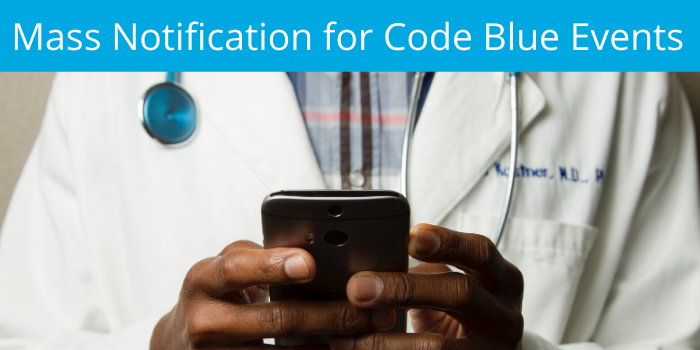Mass Notification for Code Blue Alerts
Healthcare environments pose numerous challenges when it comes to communicating information with the right group of people. Patient needs, visitor requests, and physician care obligations can all make it difficult to reach the right people with the right message. In healthcare, one of the most critical communications is a Code Blue alert. According to Healthline, “Code blue indicates a medical emergency such as cardiac or respiratory arrest.” This often requires an immediate response from doctors and nurses who can provide proper patient care. Mass notification systems can help deliver those messages to the right audience and give people the opportunity to respond so the sender knows the situation is being handled. In this blog post, we’ll go over the different notification and confirmation methods healthcare facilities can leverage for efficient Code Blue alerts and responses.
Developing and Sending Code Blue Alerts
InformaCast Fusion offers healthcare providers a quick and easy way to activate Code Blue alerts. When a cardiac or respiratory event occurs, every second matters. The time it takes to alert healthcare professionals and have them respond can mean the difference between life and death. InformaCast Fusion provides on-premises and mobile alerting methods that help ensure the right people see your message.
Using InformaCast Command Center, healthcare crisis teams can prebuild messages for Code Blue alerts that can be accessed from a web console or the InformaCast Mobile app. The message can be clearly labeled as “Code Blue”, be customized with a blue color, and can even include an icon to make it as easy as possible for users to identify and activate. When a user presses the button, it can include a prompt for the patient room number where the event is occurring. The room number will then be included in the message that gets distributed to better direct those that are responding. The message can also prompt the user to select a group to send the message to. This kind of customization can be helpful so you only deliver messages to staff who are in the facility and can provide assistance without unnecessarily alerting those who may have the day off.
When the message is sent it can be delivered as a pop-up alert on a desktop computer at a nurses’ station or to mobile devices as a phone call, push notification, or SMS text message. Each of these methods can prompt the recipient to confirm a response saying whether they can assist or if they are unavailable. Real-time metrics can be viewed by the person who activated the message from the mobile app or web console, so they know someone is responding.
InformaCast also offers the ability to configure your message to only go out in certain zones. This can help healthcare team members reduce anxiety among family members who may be in waiting areas, by having alerts only broadcast in areas where medical teams have access.
Code Blue Alerts and Coronavirus
Patients with cardiac and respiratory issues are particularly at risk when exposed to the coronavirus. Mass notification can help promote best practices in healthcare by sending reminders out via SMS text messages and postings to digital signage and desktop computers. Regular reminders of good hygienic habits can help keep people aware of the health crisis occurring and take action to do their part to prevent the spread of the disease. Mass notification can also help healthcare facilities communicate with their staff if there is an influx of patients to set expectations and request additional team members to manage the workload of a mass casualty event.
Other Emergencies
This functionality can be customized to help healthcare facilities alert and respond to any emergency situation they may face. Violent intruders, biohazard warnings, severe weather and more can all be configured as InformaCast Command Center buttons to easily trigger mass notifications that reach on-premises and mobile devices. In addition to the mobile notifications and desktop alerts mentioned above, IP speakers, IP phones, and digital signage can also be used to deliver mass notifications. Collaboration tools like Microsoft Teams and Webex can serve as endpoints and offer organizations a way to gather people in virtual spaces where they can assess a situation and plan a response. Additional triggers like virtual or physical panic buttons on IP phones, monitored CAP feeds from the National Weather Service, and Internet of Things sensors can all activate mass notifications to quickly and easily get the word out about potentially dangerous situations.
Whatever your safety and alerting needs are for your healthcare facility, mass notification can help provide a secure environment built on strong communication practices. Visit our Healthcare page for more details.
